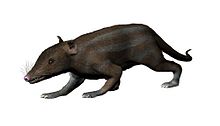Juramaia
| Juramaia Temporal range: Late Jurassic,
| |
|---|---|

| |
| Restoration | |
| Scientific classification | |
| Domain: | Eukaryota |
| Kingdom: | Animalia |
| Phylum: | Chordata |
| Class: | Mammalia |
| Subclass: | Theria |
| Genus: | †Juramaia Luo et al., 2011 |
| Species | |
Juramaia is an extinct genus of very basal eutherian mammal from the Late Jurassic (Oxfordian stage) deposits of western Liaoning, China; it is a small shrew-like mammal of body length approximately 70-100 mm.[1] Juramaia is known from the holotype BMNH PM1343, an articulated and nearly complete skeleton including incomplete skull preserved with full dentition. It was collected in the Daxigou site, Jianchang, from the Tiaojishan Formation dated at about 160 million years ago.[2] It was first named by Zhe-Xi Luo, Chong-Xi Yuan, Qing-Jin Meng and Qiang Ji in 2011 and the type species is Juramaia sinensis.[3] The discovery of Juramaia provides new insight into the evolution of placental mammals by showing that their lineage diverged from that of the marsupials 35 million years earlier than previously thought.[3] Furthermore, its discovery fills gaps in the fossil record and helps to calibrate modern, DNA-based methods of dating the evolution.[4][5] Based on climbing adaptations found in the forelimb bones, it has been suggested that the basal stock of Eutheria was arboreal, [3] in a manner resembling that of modern rats.[6]
| |||||||||||||||||||||||||
See also
References
- ^ Juramaia sinensis - 160-Million-Year-Old Fossil Pushes Back Mammal Evolution
- ^ Chu, Z.; He, H.; Ramezani, J.; Bowring, S.A.; Hu, D.; Zhang, L.; Zheng, S.; Wang, X.; Zhou, Z.; Deng, C.; Guo, J. (2016). "High-precision U-Pb geochronology of the Jurassic Yanliao Biota from Jianchang (western Liaoning Province, China): Age constraints on the rise of feathered dinosaurs and eutherian mammals". Geochemistry, Geophysics, Geosystems. doi:10.1002/2016GC006529.
- ^ a b c "A Jurassic eutherian mammal and divergence of marsupials and placentals" (PDF). Nature. 476: 442–445. 25 August 2011. doi:10.1038/nature10291. PMID 21866158.
{{cite journal}}: Cite uses deprecated parameter|authors=(help) Electronic supplementary material - ^ "Fossil redefines mammal history" BBC News
- ^ Discovery of a 160-million-year-old fossil represents a new milestone in early mammal evolution
- ^ "Forelimb Kinematics of Rats Using XROMM, with Implications for Small Eutherians and Their Fossil Relatives". PLoS ONE. 11 (3). 2 March 2016. doi:10.1371/journal.pone.0149377.
{{cite journal}}: Cite uses deprecated parameter|authors=(help)CS1 maint: unflagged free DOI (link)
